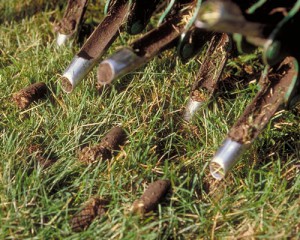“Should I scalp or aerate my lawn?” And when should I do it?
Let’s start with scalping. You set the mower to the lowest setting and bag all the clipping. You’ll need to invest in a good respirator or dust mask too because this can be a very messy process. On the positive side, it removes a lot of last year’s dead grass and also a lot of the weeds. It allows the soil to warm up fast which will make the lawn green up sooner which in turn allows you to start mowing sooner. Not only does lawn scalping promote growth, but it also thwarts diseases. Scalping your lawn eliminates a layer of thatch and thatch holds moisture.
 Aerating the lawn is another subject that gets brought up often. Aerating is the physical process of making small holes in the soil and grass. If any of the following conditions exist in your yard, you should probably aerate:
Aerating the lawn is another subject that gets brought up often. Aerating is the physical process of making small holes in the soil and grass. If any of the following conditions exist in your yard, you should probably aerate:
- Soil compact from children or pets running in the yard
- Dries out easily
- Was established by sod, and soil has been layered over an existing coarser soil. This layering disrupts drainage, as water is held in the finer-textured soil. This can lead to compacted conditions and poor root development. Aerating breaks up the layers, allowing water to flow through the soil more easily and reach the roots.
When aerating, it is better to remove a plug of soil than to just poke a hole in it. These holes allow a more efficient use of water and fertilizer by allowing them to get through layers of compacted soil and thatch. Aerating should be done during the early part of the growing season. In most case this is not a yearly task but one that should be done when needed. Click here for how to steps for aerating your lawn.
The best time to scalp or aerate your lawn is in the early spring right before the growing season begins. Stop by for all your spring gardening tools and get a head start on a beautiful lawn!





